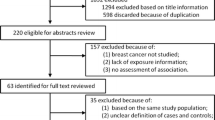Abstract
Circadian disruption (CD) was implicated in chains of cancer causation when the International Agency for Research on Cancer classified shift-work involving circadian disruption as probably carcinogenic in 2007. In the following decade, epidemiological studies into causal concepts associated with circadian disruption were inconclusive. Unappreciated complexity with an exclusive focus on shift-work, light-at-night, sleep, and melatonin in regard to circadian disruption may be accountable. With compelling non-epidemiological evidence, we posit that ubiquitous circadian disruption causes cancer and, moreover, that this is unexplored epidemiologically. This hypothesis offers a novel explanation why numerous studies in shift-workers evince inconsistent results: If circadian disruption is a ubiquitous causal phenomenon, confining assessments to the workplace, ignoring circadian disruption at play, and potential misclassification of ‘who’ is ‘when’ and ‘how much’ exposed to circadian disruption may disallow detecting the existence and magnitude of cancer risks. The rationale herein provides plausible explanations for previous observations and makes falsifiable predictions.
Similar content being viewed by others
References
Lewis P, Foster RG, Erren TC. Ticking time bomb? High time for chronobiological research. EMBO Rep. 2018;19(5):e46073. https://doi.org/10.15252/embr.201846073.
IARC. IARC monographs on the evaluation of carcinogenic risks to humans. Volume 98. Painting, Firefighting and Shiftwork. Lyon, France. 2010.
Erren TC, Lewis P. Can yesterday’s smoking research inform today’s shiftwork research? Epistemological consequences for exposures and doses due to circadian disruption at and off work. J Occup Med Toxicol Lond Engl. 2017;12:29. https://doi.org/10.1186/s12995-017-0175-4.
Erren TC, Reiter RJ, Peickarski C. Light, timing of biological rhythms, and chronodisruption in man. Naturwissenschaften. 2003;90(11):485–94.
Wittmann M, Dinich J, Merrow M, Roenneberg T. Social jetlag: misalignment of biological and social time. Chronobiol Int. 2006;23(1–2):497–509. https://doi.org/10.1080/07420520500545979.
Czeisler CA. Perspective: casting light on sleep deficiency. Nature. 2013;497(7450):S13. https://doi.org/10.1038/497S13a.
James P, Bertrand KA, Hart JE, Schernhammer ES, Tamimi RM, Laden F. Outdoor light at night and breast cancer incidence in the Nurses’ Health Study II. Environ Health Perspect. 2017;125(8):087010. https://doi.org/10.1289/EHP935.
Figueiro MG. Disruption of circadian rhythms by light during day and night. Curr Sleep Med Rep. 2017;3(2):76–84. https://doi.org/10.1007/s40675-017-0069-0.
Stevens RG. Electric power use and breast cancer: a hypothesis. Am J Epidemiol. 1987;125(4):556–61.
Kantermann T, Burgess HJ. Average mid-sleep time as a proxy for circadian phase. PsyCh J. 2017;6(4):290–1. https://doi.org/10.1002/pchj.182.
Kantermann T, Sung H, Burgess HJ. Comparing the morningness–eveningness questionnaire and Munich chronotype questionnaire to the dim light melatonin onset. J Biol Rhythm. 2015;30(5):449–53. https://doi.org/10.1177/0748730415597520.
Erren TC, Morfeld P, Foster RG, Reiter RJ, Gross JV, Westermann IK. Sleep and cancer: synthesis of experimental data and meta-analyses of cancer incidence among some 1,500,000 study individuals in 13 countries. Chronobiol Int. 2016;33(4):325–50. https://doi.org/10.3109/07420528.2016.1149486.
Erren TC, Morfeld P, Lewis P. Computing circadian misalignment: Why not combine sleep timing and duration to assess accumulated sleep deficiency? Chronobiol Int. 2017;34(10):1321–4. https://doi.org/10.1080/07420528.2017.1371729.
Erren TC, Morfeld P. Computing chronodisruption: how to avoid potential chronobiological errors in epidemiological studies of shift work and cancer. Chronobiol Int. 2014;31(4):589–99.
Srour B, Plancoulaine S, Andreeva VA, et al. Circadian nutritional behaviours and cancer risk: new insights from the NutriNet-sante prospective cohort study: disclaimers. Int J Cancer. 2018;143(10):2369–79. https://doi.org/10.1002/ijc.31584.
Kogevinas M, Espinosa A, Castello A, et al. Effect of mistimed eating patterns on breast and prostate cancer risk (MCC-Spain Study). Int J Cancer. 2018;143(10):2380–9. https://doi.org/10.1002/ijc.31649.
Lewis P, Korf HW, Kuffer L, Gross JV, Erren TC. Exercise time cues (zeitgebers) for human circadian systems can foster health and improve performance—a systematic review. BMJ Open Sport Exerc Med. 2018;4:e000443. https://doi.org/10.1136/bmjsem-2018-000443.
German National Cohort C. The German National Cohort: aims, study design and organization. Eur J Epidemiol. 2014;29(5):371–82. https://doi.org/10.1007/s10654-014-9890-7.
Van Dycke KC, Rodenburg W, van Oostrom CT, et al. Chronically alternating light cycles increase breast cancer risk in mice. Curr Biol. 2015;25(14):1932–7. https://doi.org/10.1016/j.cub.2015.06.012.
Author information
Authors and Affiliations
Corresponding author
Ethics declarations
Conflict of interest
The authors report no conflicts of interest.
Rights and permissions
About this article
Cite this article
Erren, T.C., Lewis, P. Hypothesis: ubiquitous circadian disruption can cause cancer. Eur J Epidemiol 34, 1–4 (2019). https://doi.org/10.1007/s10654-018-0469-6
Received:
Accepted:
Published:
Issue Date:
DOI: https://doi.org/10.1007/s10654-018-0469-6




